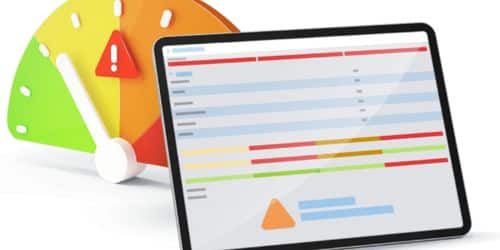Every company needs visibility into the possible dangers it faces on a regular basis. All-in-one enterprise risk management software can provide risk monitoring, identification, analysis, evaluation, and mitigation.
While many solutions address the operational and financial risks that businesses face, this article focuses on software suppliers who specialize in cybersecurity risk management systems. Here are the best free and paid risk management software vendor and solutions, followed by what every buyer should know and consider before making a purchase.
Best Risk Management Systems Software Overviews
Here is a quick summary of each of the best risk management systems software on this top ten list.
#1. Clickup
Color-coded sections with hyper-customizability can help you detect risks at a look.
ClickUp is a project management tool that includes features such as time tracking, resource management, task management, and reporting. So, why are we categorizing it as risk management systems software? Because of its extensive customization and robust dashboards.
A list view can be used to record any risks that your project is facing or may face. This list can be kept in your project space or folder and kept up to date so you are aware of any dangers to your project goals. What is the secret? Color-coding.
Create a colorful way to quickly identify risk and prevent project delays and other errors by using drop-down and priority fields.
ClickUp has native connectors with Slack, G Suite, Dropbox, and many other apps, as well as over 1,000 Zapier integrations.
ClickUp is a free risk management software service with limited storage available to an unlimited number of users. Paid subscriptions begin at $5/user/month and include a 30-day free trial.
#2. Fusion Framework System
Best risk management software for dependency visualization.
The Fusion Framework System is an operational resilience software that is cloud-based and runs on top of the Salesforce platform. The Fusion Framework accelerates the digital transformation of risk management and business continuity programs by bringing together data, systems, people, processes, services, and more on a single platform.
The tool allows you to visualize your business, products, and services from the perspective of your customers, providing a map of your company’s day-to-day operations. Organizations can use the dependency visualization functionality to identify effects and examine linkages based on risks, processes, applications, and third parties.
The Fusion Framework adjusts to changing priorities and gives context for using risk intelligence. Within Fusion, users may structure their process-risk-control architecture to generate a robust process profile that ties to risks and controls. You may do risk assessments, measure metrics across the organization, provide step-by-step instructions for managing controls, organize and document control requirements, and resolve difficulties.
Everbridge’s emergency notification system and risk intelligence, Send Word Now, Onsolve, and ServiceNow are among the Fusion Framework System interfaces.
Fusion Framework System pricing is available upon request.
#3. StandardFusion
Best mid-market risk management systems software
StandardFusion is an end-to-end Risk Management platform designed to provide enterprises with the visibility, centralization, and collaboration required to reduce information security risk and enable information security teams to drive revenue development.
The platform is comprised of six core solutions (Risk, Compliance, Audit, Vendor, Policy, and Incident), each designed to be highly configurable with centralized data so that users have visibility across all of their risk and compliance programs at any stage and can produce an evidence report to satisfy audits and stakeholders at any time.
In terms of compliance features, StandardFusion natively supports the following standards: IPAA, FEDRAMP, NIST, ISO, PCI-DSS, SOC 2, GDPR, and CCPA. You can start by utilizing StandardFusion as is, and then you can adjust its characteristics to your organization’s needs.
The risk management tools assist you in assessing and tracking specific risks, mitigating actions, and outcomes, which can be rapidly summarized using the report generator. There are no surprises in the pricing terms. And all levels give users complete access to the platform’s capability, with additional features and connectors included as the scale of the plan.
Jira, Confluence, Slack, OpenID, DUO, and Google Authenticator are just a few of the existing integrations for StandardFusion. They also include possibilities for single sign-on, integrations with UCF, and API access.
Standard Fusion pricing starts at $1250 per month for three users.
#4. Project Risk Manager
Best for modifying system parameters
To assist the user in selecting and ranking the most relevant effects for each risk, Project Risk Manager software employs pre-defined impact categories and impact rank descriptions. The state of each mitigation applied to the risk is used to calculate risk status.
At the moment, Project Risk Manager is only available as a desktop download. For people who are used to dealing with applications via their chosen web browser or via a mobile app, this could be considered a disadvantage of the software.
Users should look for the Project Risk Manager’s exceptional capacity to undertake deep research by constructing a pyramid of important risks.
Project Risk Manager starts at $18.50/month for hosting plus $1.22/user/month for software and includes a freemium version.
#5. Acumen Risk Management
Best in terms of user experience and usability
Acumen Risk simply connects schedule risk to cost risk to quantify the influence of project cost estimates on schedule delays. The program’s Risk Advisor proposes uncertainty settings for your project activities to help accelerate risk loading and defines the genuine inputs to risk models.
Acumen Risk’s user interface (like with many Acumen products) is sleek, intuitive, and informative. The low and high-risk zones are visible and readable even from a distance or with a quick scan. This resulted in a high UX consideration of the evaluation criteria.
Acumen Risk might expand its library of support materials, which has a dedicated jump link on its website but only goes to three resource items (at the moment)—one guide, one client story, and one webinar.
The data visualization versatility and simple access to real-time information will appeal to users.
Acumen Risk management software provides pricing on request, as well as a free trial and demo.
#6. Pims Risk
Best for risk response planning
Pims 365 is a fully integrated project management tool that drives project progress during key times. This was created for the construction industry and integrates technical and commercial data as a foundation for recognizing and controlling project risks.
Pims Risk features a customizable per-user monthly price, making it an excellent solution for cost-conscious companies. Their pricing plan is transparent and free of surprises, earning them high marks in the Value for Cost category of the evaluation.
This tool focuses heavily on risk assessment but is lacking in other areas that typically supplement such protocols, such as compliance management, incident management, and internal controls management.
Pims Risk management software starts at $27 per person per month and includes a free sample.
#7. TrackMyRisks
Best in terms of automation capabilities
TrackMyRisks allows you to store, sort, and manage all of your governance, risk, and compliance documents in one place—upload and share PDFs, Office documents, photos, and more. Automatic version control, in-system notifications, and the ability to automate document expiry reminders are among the features.
The risk management software features templates for easier workflow, single source documentation, and tracking notes for convenient review, TrackMyRisks excels at eliminating repetitive, mundane chores and freeing up administrative time.
TrackMyRisks’ UX/UI could be improved, as certain process pathways are clunky and difficult to traverse. The user journey features a few speed bumps, which cost them a sliver of value in the assessment criteria’s UX category.
Risk managers will enjoy TrackMyRisks’ privacy-by-design and default approach to management and task sharing and permissions.
TrackMyRisks risk management software starts at $37 per month and offers a free sample.
#8. Opture
The best risk reporting features
Opture GRC software integrates a professional Enterprise Risk Management (ERM) System, Internal Control System (ICS), and Compliance. This enables the calculation of enterprise-wide critical risk statistics for all three themes, as well as all process and organizational structures.
Opture GRC excels at several characteristics, including robust, comprehensive, and adaptable reporting systems, as well as straightforward and logically designed processes. Furthermore, the installation is simple and seamless.
One disadvantage of the tool is that it lacks features for alerts/notifications and corrective actions (CAPA).
Data-hungry teams would like Opture’s robust and versatile reporting system, which is something I constantly seek in my evaluation criteria.
Opture risk management software features a one-time fee of $1500 per user and a free demo.
#9. IsoMetrix
Best for drag-and-drop functionality
The IsoMetrix enterprise risk management system establishes a centralized platform for an integrated approach to managing an organization’s risks. Every process in the organization is identified and assessed for risks with an emphasis on critical control management.
The flexibility of the setting choices is a notable aspect of IsoMetrix that I wish to highlight. Work with the IsoMetrix team to customize the software according to your organization’s risk assessment needs.
IsoMetrix has a steep learning curve, so managers should expect a lengthy onboarding process and plenty of troubleshooting at first. As a result, they received a few points less in the Usability area of the evaluation criterion.
Overall, I commend IsoMetrix’s strong approach to simple board reports and yearly reports, which any risk management team will comprehend.
IsoMetrix risk management software offers a free demo as well as pricing upon request.
#10. @RISK
Best for Microsoft Office users
@RISK (pronounced “at risk”) is a Microsoft Excel add-on that allows you to analyze risk using Monte Carlo simulation. @RISK displays practically all conceivable outcomes for each situation, as well as their likelihood and how to avoid them.
The software’s robust documentation and networking processes are among its best features. If you already use the Microsoft Office Suite, adding @RISK as an add-on is a no-brainer because the learning curve will be low and will supplement your previous knowledge.
One clear disadvantage of the software as an add-on to Microsoft Excel is that you must be a Microsoft user in order for it to work. If you don’t already use Excel on a daily basis, you’ll have to learn two new technologies at the same time.
@RISK risk management systems software starts at $1795 per year and includes a free 15-day trial.
What is Risk Management?
The process of detecting threats, monitoring their exploitability status, conducting internal audits, and managing risks to reduce harm to a firm or organization is known as risk management.
Prior to the IT revolution, brick-and-mortar stores and enterprise offices used security guards, alarms, and CCTV to defend physical assets from threat actors. A lock kept the cash, patents, and other valuables safe behind closed doors.
What Is Enterprise Risk Management?
Enterprise risk management (ERM) is a risk management system for enterprises with thousands of people, global networks, and an increasingly sophisticated IT environment. While traditional risk management frameworks provide risk strategy to division managers, ERM is the macro-view and risk management method for an organization’s collective risk posture.
What Are the Different Types of IT Risk Management?
The objectives of information security — confidentiality, integrity, and availability – provide insight into the types of risks that threaten IT infrastructures.
Organizations must keep some client or proprietary data confidential, as well as guarantee that it is reliable and accessible to appropriate users such as staff and clients. Given the increasingly interwoven and complicated nature of risk management across the enterprise, most IT risk falls under one of these objectives, if not some overlap.
Common Risks Examples
| IT Threat Type | Relates to… | Examples |
| Physical | Access to physical systems | Natural disaster, fire, shoulder surfing |
| Technical | System failure | Software bug, crash, loss of data |
| Digital | System compromise | Phishing, malware, ransomware |
| Human Error | Staff of user access | Accidental misconfiguration |
| 3rd Party | External parties | Suppliers, partners, and stakeholders |
IT risk management strategies and solutions are required for today’s enterprise businesses to avoid these threats to business continuity.
What are the Benefits of Risk Management Systems Software?
Maintaining an efficient security architecture necessitates the capacity to act quickly in order to thwart intruders. The advantages of risk management software include the ability to swiftly discover hazards, assess their danger, and improve risk mitigation measures.
The capacity to prioritize which risks should be addressed first guarantees that resources are allocated appropriately. In turn, organizations can avoid the financial and operational risks posed by breaches or outages entirely. With the increased adoption of IT and the economy’s reliance on its continuous functionality, addressing these risks is becoming more expensive by the day, especially when legal and compliance ramifications are considered.
What are the Features of Risk Management Software?
- Risk Identification: Scans networks for emerging risks and vulnerabilities.
- Alert System: Detects and notifies particular team members of potential dangers.
- Risk assessment: This is the analysis of risks and vulnerabilities to evaluate the severity of the threat and the resources affected.
- Prioritization of risks: Determine which risks will cause the most damage and notify operators of the relevant task.
- Centralized Dashboard: All logs of threats and vulnerabilities are displayed in a single dashboard, with automatic patching and mitigation capabilities.
- Reporting and audits: Create risk reports and retain historical data from previous occurrences to assist inform future responses.
- Regulatory Compliance: This should aid in the maintenance of GRC and internal standards.
How to Select a Risk Management System
#1. Organizational Requirements
First, you must determine your fundamental requirements. Some risk management software is designed to target specific types of risk. Some tools, for example, focus on project risk management, whilst others focus on financial risk management. Several top risk management software programs provide specialized compliance-related risk protection, such as GDPR, GLBA, and HIPAA.
Similarly, an SMB serving a small region will not require the same level of enterprise-level features as a worldwide network of offices.
#2. Interoperability with Existing Systems
The next thing to think about is how a solution will integrate with your present technological stack. You should make sure that the products you’re thinking about can work with other security solutions you currently have in place, such as:
- Manager of security incidents and events (SIEM)
- Firewalls of the future (NGFW)
- Analytics of user and entity behavior (UEBA)
- Detection and response to endpoints (EDR)
Choosing a product that does not integrate with your present security architecture may result in security holes or costly tool overhauls to match the risk management solution.
#3. Budget and Agreement
Finally, determine your budget and contract specifications. Advanced RM solutions, like those that incorporate artificial intelligence (AI) or are designed for large businesses, are frequently far more expensive than alternatives. If you don’t need these more complex capabilities, make sure you’re not paying too much.
Conclusion
As with most software, the future of risk management solutions will feature significant developments as well as the use of machine learning and AI. These new technologies assist RM software in better identifying and preventing cybersecurity weaknesses, identifying signatures of existing assaults, and forecasting more advanced threats via anomaly detection. As possible attacks become more sophisticated, security solutions will undoubtedly evolve to handle tomorrow’s risks.
Risk Management Software FAQs
What are 5 risk management tools?
- Risk Register.
- Root Cause Analysis.
- SWOT.
- Probability and Impact Matrix.
- Risk Data Quality Assessment.
How does risk management software work?
The software collects data from around the organization to identify potential risks. Typically, risk management software assesses the risks associated with a certain group of assets and then communicates that risk to the organization so that action may be taken.
What are the steps of software risk management?
- Identify risks and their triggers.
- Classify and prioritize all risks.
- Craft a plan that links each risk to mitigation.
- Monitor for risk triggers during the project.
- Implement the mitigating action if any risk materializes.
- Communicate risk status throughout the project.
Related Articles
- Top 10 Digital Marketing Companies in Nigeria (Updated!)
- MARKET RISKS: Best Practices and Easy Guide with Examples
- BUSINESS RISK: How to Manage Risks in Business
- What Is Business Continuity Management? (Comparison of Business Continuity Management Software)






